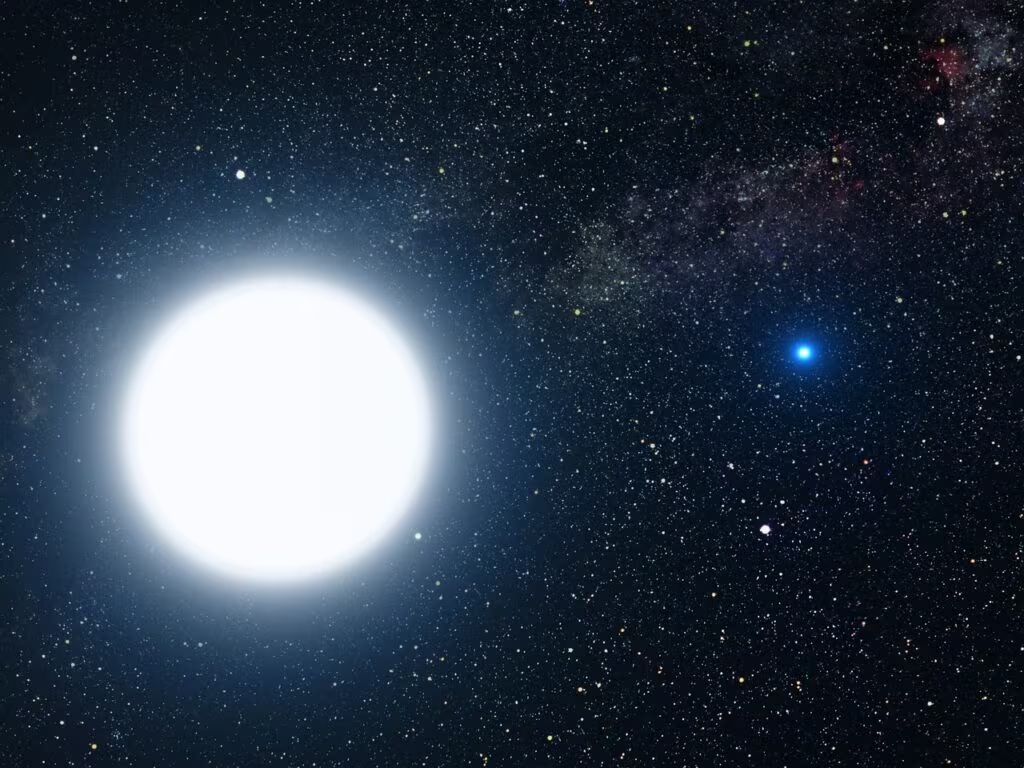Unlocking the Secrets of Stellar Cannibalism
For the first time, astronomers have achieved an unprecedented view of the chaotic, high-energy environment surrounding a white dwarf star as it actively siphons material from its companion—a phenomenon often dubbed stellar “vampirism.”
Using NASA’s specialized Imaging X-ray Polarimetry Explorer (IXPE) spacecraft, scientists were able to measure the polarization of X-rays emanating from the system. This crucial data provides the clearest picture yet of the geometry and physics governing the feeding process, offering deep insights into the powerful magnetic fields that shape these exotic binary systems.

Decoding the ‘Vampire Star’ System
The observed system is a type of Cataclysmic Variable (CV), a binary star arrangement where a dense, dead star—the white dwarf—is locked in orbit with a normal, living companion star. The white dwarf’s intense gravity strips hydrogen and helium gas from the companion, forming a swirling structure known as an accretion disk.
In many CVs, particularly those known as magnetic CVs (Intermediate Polars or Polars), the white dwarf possesses an extremely powerful magnetic field. This field acts like a cosmic funnel, disrupting the inner part of the accretion disk and channeling the infalling matter directly onto the star’s magnetic poles.
This process generates enormous amounts of energy, primarily released as high-energy X-rays, making these systems some of the brightest X-ray sources in the galaxy. However, observing the precise structure of this inner region has historically been challenging because standard X-ray telescopes only measure brightness and energy, not the orientation of the light waves.
The Challenge of Accretion Geometry
Understanding the geometry of the accretion flow—how the gas moves and where it hits the star—is fundamental to modeling stellar evolution in binary systems. Previous models relied heavily on indirect evidence. The new IXPE observation changes this by providing a direct geometric measurement.
The Power of X-ray Polarimetry
IXPE is unique because it measures X-ray polarization. Polarization is the measurement of the direction in which light waves oscillate. When light is emitted or scattered in a highly ordered environment, like a strong magnetic field, the resulting X-rays become polarized in a specific direction.
By measuring this polarization, astronomers can deduce the physical layout of the emitting region, including:
- The orientation of the magnetic field lines.
- The shape of the accretion column.
- The size and location of the shock region where the infalling material slams into the white dwarf’s surface.

What the IXPE Data Revealed
The IXPE data provided the first clear look at the innermost region of the accretion flow, confirming key theoretical predictions. The polarization measurements showed that the X-rays were highly ordered, indicating that the material was indeed being channeled along powerful magnetic field lines.
Specifically, the data allowed scientists to determine the precise angle at which the X-ray emitting plasma was oriented relative to the white dwarf’s rotation axis. This confirmed the model where the gas stream is heated to millions of degrees as it decelerates rapidly upon hitting the star’s surface, creating a shock front that emits the observed X-rays.
“This is the first time we’ve been able to directly ‘see’ the geometry of the accretion flow in such detail,” stated a lead researcher involved in the study. “Measuring the polarization gives us a new dimension of information that brightness and energy alone could never provide. It’s like moving from a flat photograph to a 3D model.”
This level of detail is critical for refining models of how energy is dissipated in these highly magnetized environments. The measurements helped validate the long-held assumption that the magnetic field dominates the flow right up to the star’s surface.
Broader Implications for Stellar Evolution
This breakthrough observation using IXPE has implications that extend beyond just Cataclysmic Variables. Understanding how magnetic fields manage the transfer of mass and energy is vital for studying other extreme stellar objects, including:
- X-ray Binaries: Systems where a normal star feeds a neutron star or a black hole. These systems operate on similar accretion principles, but with even more extreme gravity.
- Young Stellar Objects (YSOs): Newly formed stars often possess strong magnetic fields that channel material from their surrounding protoplanetary disks. The physics of accretion columns studied in white dwarfs can inform models of how planets form.
- Supernovae Precursors: The mass transfer in CVs can eventually push the white dwarf past the Chandrasekhar limit (1.4 solar masses), potentially triggering a Type Ia supernova—a key cosmic event used to measure the expansion of the universe.
By precisely mapping the magnetic geometry in this relatively nearby “vampire star,” astronomers gain a crucial benchmark for modeling these more distant and energetic phenomena. The ability of IXPE to provide geometric data—not just spectral data—opens up a new era of high-energy astrophysics.

Key Takeaways
The IXPE observation of the feeding white dwarf represents a major step forward in understanding magnetic binary systems:
- First Geometric View: It provided the first direct measurement of the geometry of the inner accretion flow using X-ray polarization.
- Validation of Models: The data strongly supports existing theoretical models that predict how powerful magnetic fields funnel superheated gas onto the white dwarf’s poles.
- New Tool for Astrophysics: X-ray polarimetry has proven to be a powerful technique for studying the structure and physics of extreme cosmic environments where magnetic fields dominate.
- Broader Context: Insights gained here are applicable to other high-energy systems, including black hole and neutron star binaries, and even the formation of young stars.
Conclusion
NASA’s IXPE mission has successfully delivered on its promise to provide a new dimension of observational data, transforming our understanding of stellar cannibalism. By revealing the precise structure of the magnetic funnels that guide the stellar material, scientists have moved beyond theoretical assumptions to direct observation. This geometric clarity is essential for accurately modeling the fate of binary stars and the role of magnetic fields in the most energetic processes in the cosmos. Future IXPE observations are expected to target a wider variety of these magnetic CVs, further refining our knowledge of these fascinating stellar interactions.
Original author: Robert Lea
Originally published: November 21, 2025
Editorial note: Our team reviewed and enhanced this coverage with AI-assisted tools and human editing to add helpful context while preserving verified facts and quotations from the original source.
We encourage you to consult the publisher above for the complete report and to reach out if you spot inaccuracies or compliance concerns.

